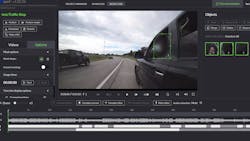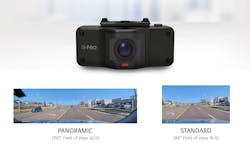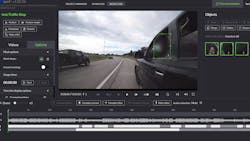The variety of video devices available to law enforcement agencies and the ability to manage data from those devices is ever-evolving. Body-worn and in-car video systems have become a necessary part of an officer’s job and often hold the key to supporting cases once in court.
OFFICER Magazine reached out to David O’Connor, Director of the Public Safety Division at i-PRO Americas Inc., in search of answers to some pressing questions surrounding the use of video by law enforcement and what is next as the technology only continues to advance.
How important is the use of video by law enforcement agencies?
From a community, law enforcement and legal perspective—very important. A strong camera program offers law enforcement agencies a unique and rare opportunity to strengthen their relationship with the communities they serve. Consistent use of a video evidence system instills public confidence and trust that every incident involving law enforcement officers directly interacting with the public has complete transparency. It also promotes both officer and public compliance, as individuals are more likely to conform with protocols and verbal orders from officers when they know they are being recorded.
This article appeared in the July issue of OFFICER Magazine. Click Here to view the digital edition. Click Here to subscribe to OFFICER Magazine.
Video also helps protect law enforcement departments dealing with false allegations of officer misconduct and validates that department protocols were followed. Addressing such allegations can be time consuming and disruptive to other mission-critical tasks. Prompt access to, and the subsequent release of, undisputable video evidence can help resolve disputes quickly and efficiently.
Lastly, the introduction of video evidence in a court of law will greatly reduce an agency’s resources spent during criminal proceedings. Just as every citizen has a cell phone camera ready and available to record police activity, law enforcement agencies must also be ready and able to record activities in the field in order to provide a complete and unbiased documentation of events. Without video evidence from law enforcement officers involved in the events, prosecutors may be unable to piece together a clear picture of what actually took place.
How has the use of video by law enforcement agencies evolved?
The most noticeable shift has been in the submission of video evidence during criminal proceedings. Previously, video evidence was considered just one piece of the larger evidentiary puzzle. Now, many prosecutors refuse to prosecute certain crimes, such as DUI/DWI/OWI/OMWI/BUI, in the absence of video evidence corroborating an officer’s report. Similarly, some judges refuse to hear certain cases if video evidence is not available. These actions make it more difficult to identify repeat offenders and offer little recourse for victims, further straining police-public relations.
On the plus side, the accumulated library of video recordings available from longstanding camera programs is now being used as a valuable training aid. New and experienced officers are using these recordings to continue their skills and training development based on real events and encounters. Agencies also use on-the-job video recordings to conduct individualized performance reviews, ensuring every officer is adhering to department protocols.How do body cameras and in-car video systems work together?
Each camera system has its own advantages. For example, in-car video systems can be securely mounted on a stable platform with access to reliable power. This supports the deployment of multiple larger cameras for full 360-degree coverage, extended record time and other advanced features. On the other hand, body cameras provide mobile documentation of events that happen outside of a vehicle’s proximity. Recording from an officer’s point of view captures the video and audio of direct interaction with individuals, including visual cues which may have led to incident escalation.
When body cameras and in-car video are deployed in tandem, triggers activating the in-car system simultaneously start recording with the body camera. This provides flexibility and mobility for the officer while also eliminating the manual recording process that can be forgotten during high-pressure situations. Combining recordings from both in-car video and first-person body camera video provides a more complete documentation of most situations.What role does digital evidence and redaction software play?
Capturing the recording is only the beginning of the work required to accurately document each event or interaction. Digital evidence management tools streamline the process of moving video from mobile devices to server-based or cloud-hosted systems. AI-powered software within digital evidence tools can then automatically categorize and organize the vast number of recordings captured, eliminating unnecessary recordings and quickly establishing an event timeline. These tools also ensure the integrity of video evidence by supporting audit logs, controlled viewing access, chain of custody records and anti-tampering measures.
Redaction capabilities are also increasingly important for the protection of privacy and citizens’ rights in accordance with the law. The redaction of faces and license plates from video evidence has historically been a time-consuming manual process. Automated redaction software effectively saves time and budget by reducing up to 90% of the manual effort associated with editing video files. The automation provided by digital evidence management and redaction software improves internal workflows and simplifies back-end processes associated with law enforcement camera programs.
What are some of the current trends in law enforcement video?
Body-worn cameras are evolving from their initial use as video and audio recording devices to include mobile sensor capabilities. In this way, the body camera effectively becomes its own “smart” device capable of delivering insights to officers in real time. For example, specific audio or video “signatures” picked up by the camera can alert the officer to a change in his or her environment. In threatening situations, such alerts can be critical.
There has also been a growing call to improve the running time of a body-worn camera’s battery life. At i-PRO, we addressed this challenge by introducing a 12-hour detachable battery that can be easily swapped in the field during extended shifts and deployments. The demand for wide fields of view capable of capturing a greater context of an event is also trending. Wide angle image capture traditionally presented image distortion and clarity challenges in the past, but many of these have been overcome with the latest imaging technologies. Another trend in law enforcement video extends beyond hardware to include back-end video processing, such as the ability to review multiple videos simultaneously using time synchronization. As the quantity of video footage gathered from body-worn and in-car cameras increases, the need for four, six or even 12 videos to be synchronized is not uncommon. We are always seeing and responding to the growing demand for new imaging tools that provide automated assistance for mundane, labor-intensive tasks.
This article appeared in the July issue of OFFICER Magazine.
About the Author
Paul Peluso
Editor
Paul Peluso is the Managing Editor of OFFICER Magazine and has been with the Officer Media Group since 2006. He began as an Associate Editor, writing and editing content for Officer.com. Previously, Paul worked as a reporter for several newspapers in the suburbs of Baltimore, MD.




